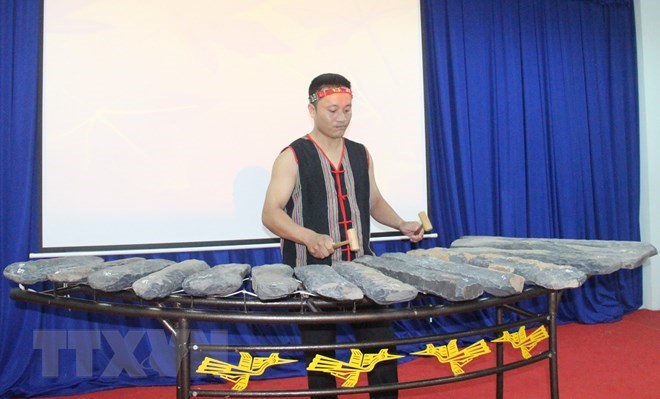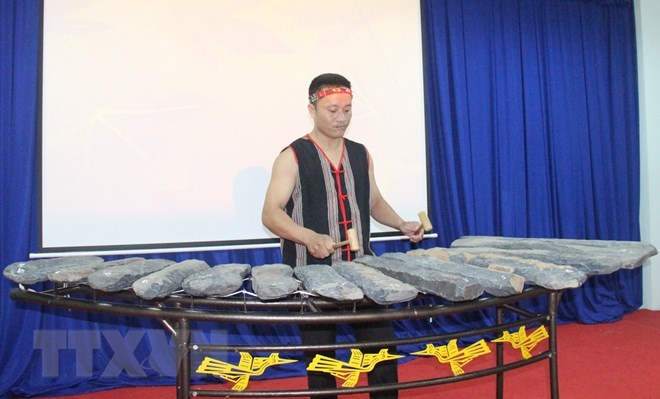
The southern province of Binh Phuoc announced the Prime Minister’s decision to recognise an ancient Loc Hoa lithophone as a national treasure during a ceremony in the provincial museum on August 28.

A musician performs on ancient Loc Hoa lithophone. (Photo: VNA)
The lithophone, found by a local farmer in 1996, is among 24 artifact sets
honoured as national treasures by the PM in the sixth series of recognition
last year.
Bui Huu Trieu was digging in his garden in Village Eight, Loc Hoa Commune, Loc
Ninh District, when he found 12 pieces of an ancient musical instrument lying
next to each other in size order. After informing the communal
authorities about it, he continued to discover another 14 pieces of the
instrument.
Since its discovery, the Loc Hoa Lithophone has been studied by many state
agencies, as well as experts both at home and overseas, who believe the
instrument was created by ancient peoples more than 3,000 years ago.
The recognition of the Loc Hoa lithophone as a national treasure shows the
distinctive culture of the ancient Vietnamese in Binh Phuoc, said Deputy
Director of the Binh Phuoc Department of Culture, Sports, and Tourism Do Minh
Trung at the event.
Pham Huu Hien, Deputy Director of the Musuem of Binh Phuoc said the museum will
exhibit the lithophone for public view, adding that it will promptly draw up
plans to safeguard the artifact and promote its value.
Source: VNA
With an increasingly vibrant and widespread emulation movement aimed at building cultured residential areas and cultured families, Yen Thuy District has been making steady progress toward improving both the material and spiritual well-being of its people, while fostering a civilized, prosperous, beautiful, and progressive community.
Once lacking recreational spaces and community facilities, Residential Group 2 in Quynh Lam Ward (Hoa Binh City) has recently received attention for the construction of a new, spacious, and fully equipped cultural house. The project followed the model of state support combined with public contributions in both labor and funding.
The "All people unite to build cultural life" movement, which has been effectively integrated with Kim Boi district’s socio-economic development goals, is fostering a lively spirit of emulation across local residential areas, hamlets, villages, public agencies, and enterprises. In addition, through the initiative, traditional cultural values are being preserved and promoted, while community solidarity and mutual support in poverty reduction and economic development are being strengthened.
A working delegation of the Hoa Binh provincial People’s Committee led by its Permanent Vice Chairman Nguyen Van Toan on June 11 inspected the progress of a project to build the Mo Muong Cultural Heritage Conservation Space linked to tourism services in Hop Phong commune, Cao Phong district.
Born and growing in the heroic land of Muong Dong, Dinh Thi Kieu Dung, a resident in Bo town of Kim Boi district, in her childhood was nurtured by the sweet lullabies of her grandmother and mother. These melodies deeply imprinted on her soul, becoming an inseparable part of her love for her ethnic group's culture. For over 20 years, this love for her hometown has driven Dung to research, collect, and pass down the cultural values of the Muong people to future generations.
In the final days of May, the Ethnic Art Troupe of Hoa Binh Province organized performances to serve the people in remote, mountainous, and particularly disadvantaged areas within the province. These were not just ordinary artistic shows, but they were the meaningful journeys aimed at spreading cultural values, enhancing the spiritual life of the people and contributing to the preservation of ethnic minority cultural identities.



